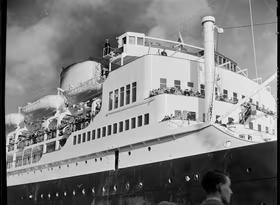Migration flows symptomatic of NZ’s economic problems
This opinion piece was first published on Stuff on 8 April 2024.
The unprecedented migration surge since mid-2022 has seen a net 110,000 working-age people added to the population during the last 12 months. This outcome is a flow-on effect from the labour market disruption caused by the borders being shut during COVID-19. Businesses have needed to fill longstanding vacancies, and large immigration inflows have been facilitated by the government’s Green List, targeting roles as diverse as ICT project managers and excavator operators.
Having rectified the imbalances caused by the pandemic, the focus must now shift to what medium-term goals immigration policy is trying to achieve, and what is a sustainable level of immigration. With New Zealand housing still highly unaffordable compared to incomes, and with the country’s infrastructure creaking after decades of underinvestment, there must be a strong temptation for the government to clamp down on immigration to prevent these problems worsening, but a more balanced approach is needed.
Nothing has changed post-COVID
In that vein, back in May 2021 the previous government announced an “immigration reset” – a proposal that turned out to be very short-lived. It was light on details, but at its heart was a desire not “to simply turn on the tap to the previous [pre-COVID] immigration settings.” At face value, the reset threatened to embed labour shortages in the economy in the name of industry transformation and the quest for higher-value jobs. The reset had little thought about how to fill the gaps that had previous been aided by migration and were becoming more obvious the longer the borders for shut.
The thinking behind the reset was doubly naïve in its belief that access to workers from overseas could remain heavily constrained, despite highly stimulated economic conditions in the pandemic’s aftermath. Other sentiments expressed were closer to the mark, although the policy didn’t realistically try to achieve these sentiments. In particular, the reset talked about the balancing act for immigration policy, between recognising and meeting the skills shortages in the short-term and fostering an environment of sustainable economic growth over the longer-term.
At its most simple, bringing in excavator operators from overseas would seem to be of questionable value over the medium term, when we should be able to train some of our own young people to do the job. By the same token, one would expect Kiwis to be able to fill other lower-skilled labour market holes such as chefs, aged care workers, or fruit pickers in the short term, as well as higher-skilled roles over the longer term with appropriate training. But as we saw during the pandemic, many Kiwis are simply not willing to do the lower-skilled jobs – at least, not at the wages being offered.
Better productivity and incomes is the only sustainable future
How do we change our economy’s operating model so that we are not so heavily reliant on labour to grow and meet demand? This question becomes even more relevant in the context of the aging population, with an ever-smaller proportion of workers available to produce the goods and services demanded across the economy.
New data on New Zealand’s productivity performance is due out next week. Given the labour constraints that were still being felt during 2022/23, it is possible that the latest year’s data will show a relatively good labour productivity result as we all worked harder to get things done – but a result that is likely to be reversed during 2023/24 as economic growth has stalled. The underlying trend will continue the faltering trend of the last two decades, with average labour productivity growth of 1.3%pa between 2000 and 2022, well below the 2.8%pa average between 1985 and 2000.
There are a few brighter spots amid the gloom – retail trade, along with accommodation and food services, have recorded improving labour productivity growth in recent years. This outcome suggests that the adoption of technology, perhaps precipitated by the rising minimum wage, is reducing the labour-intensity of operations. But across the primary sector, much of the manufacturing industry, and most other service industries, the bigger labour productivity improvements of the 1990s are a distant memory.
If harnessed correctly, automation or AI have the potential to supersede a lot of the lower-skilled roles throughout the economy. The challenge then becomes how we appropriately train displaced workers and young people entering the workforce for jobs in tomorrow’s economy. The immediate signs are not good. After years of disruption caused by COVID-19 and government reforms, the tertiary education sector remains in a state of flux as it grapples with funding shortfalls, lower student numbers, and a lack of coordination with future workforce requirements.
Amid this malaise, as long as incomes in New Zealand remain 25-30% below those in Australia, we’re fighting a losing battle to retain our best and brightest anyway. At over 257,000 arrivals during the last year, the inward part of the migration equation has got plenty of airtime, but the record high of 123,000 departures has received less attention. It has surpassed the outflow in 2011/12 caused by the combination of the Global Financial Crisis, the 2011 Christchurch earthquake, and the Australian mining boom. The outflow is now a massive 43% higher than the average during the second half of the 2010s.
Ultimately, migration is only a symptom of the problems we face as a country. We need to start making better use of the resources we have. Otherwise, at best, any inflow of workers will only be filling the bucket as fast as water is leaking out the holes in the bottom.















